皮艇
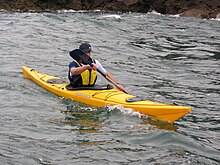




皮艇(英語:kayak,伊努克提圖特語:ᖃᔭᖅ Inuktitut pronunciation: [qaˈjaq];尤皮克語:qayaq,意思「獵人艇」)是一種類似獨木舟的窄體水上載具,有單人和多人(通常為雙人)兩種,外型源自亞寒帶愛斯基摩人(因紐特人和尤皮克人)和阿留申人傳統涉水漁獵使用的獸皮艇。皮艇主要以人力驅動,通常用一支略長的雙頭槳於艇的左右兩邊依次划水,但現代設計可能配有用踏輪或電動機驅動的人造腹鰭或螺旋槳。
皮艇比較全體木製的獨木舟要輕巧得多,划艇者的座位周圍通常有防水的皮或橡膠膜與划艇者的上衣相連,在保證排水量的同時可以防止艇內進水,一般在艇的前後都有水密空間作貯存用。艇內有腳踏,可讓划艇者雙腿伸直坐立以便休息,並且可以借力幫助上身的划槳,
歷史
[編輯]
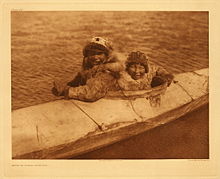


皮艇最開始由東北亞和北美亞寒帶的原住民(因紐特人、尤皮克人和阿留申人)發明,用來在內陸湖泊、河流和北冰洋、白令海、北太平洋和北大西洋的沿岸水域進行狩獵。這些原版皮艇的製造方式是將鰭足類海洋哺乳動物(海豹、海獅等)或其他陸生動物的毛皮縫在木製或鯨鬚(主要是東部因紐特人,因其居住地區在林木線以外)框架上,有至少4000年的歷史[2]。最古老的現存皮艇現展覽於慕尼黑的五大洲博物館,源於1577年[3]。
這些原住民使用皮艇的目的也不同。阿留申皮艇(baidarka,源自俄語:Байдарка)通常為雙人或三人艇,主要用於狩獵和阿留申群島各島嶼間的運輸。尤皮克和因紐特皮艇(umiak)則是航行外海用的皮艇,長度在5.2—9.1米(17—30英尺)之間,用海豹皮和木框所制,但使用單頭槳和多人駕駛。原住民的造船經驗是通過口頭代代相傳,而傳統的皮艇通常都是獵手按照自己的體型和操作需求親手(加上配偶幫助手縫獸皮)製造。
傳統的皮艇手會身著因紐特皮衣(tuilik)並且罩在圍板上,在關鍵位置(比如圍板口、袖口和帽兜)用束帶固定用來密封防止漏水。這種穿著配置使得獵手在萬一皮艇發生翻覆後可以輕易用「愛斯基摩翻滾」(Eskimo roll)或同伴相助的方式恢復直立,不需要被迫離開皮艇游泳(大部分因紐特人並不會游泳,因為游泳反而會因為寒冷的極地水溫造成失溫症更快死亡)[4]。現代的皮艇手通常不穿著皮衣,而是用防水的彈性合成材料製成防水甲板方便密封,同時在需要進出皮艇時可以迅速釋放開。
傳統皮艇分為三類:最古老的阿留申皮艇常見於白令海和阿留申群島,形狀較圓並且擁有多個頷線,看起來頗似軟式飛艇;西格陵蘭皮艇則頷線較少、稜角分明,船舷在船首和船尾分別揚起;以及東格陵蘭皮艇,形狀與西格陵蘭皮艇相似,但更為緊身而且在船舷與艏柱之間的夾角更陡,操縱性更好。因紐特人對造艇有非常具體的測量標準——皮艇的長度通常是艇手臂展的三倍,座艙的寬度不超過艇手的臀寬加上兩個拳頭,高度通常是握拳伸直拇指後的手長。這種常見的尺寸通常是艇長5.2米(17英尺)、艇寬51—56 cm(20—22英寸)、艇高18 cm(7英寸)。因為每個皮艇都各不一樣,這使得早期的歐洲探險者當年試圖仿製皮艇時迷惑不堪。
大部分阿留申人和格陵蘭因紐特人都依賴皮艇進行各種涉海或登陸狩獵,除主要獵物的海豹之外還包括鯨類和陸上的馴鹿。如今,格陵蘭島上的因紐特人仍然使用傳統的「外皮套內框」皮艇進行狩獵,因為平軟的毛皮在涉水時可以安靜的滑過風浪。世界上其它地區也有各種依照傳統方式製造皮艇的工匠,但是常常使用帆布或合成布料(比如彈道尼龍)。
現今的傳統式皮艇主要源自阿拉斯加、加拿大北部和格陵蘭西南的原住民船舶。雖然用現代布料套在木製框架上的摺疊皮艇(德語:faltboot或Hardernkahn)最早在1905年由德國慕尼黑的建築系學生阿爾弗萊德·赫里希(Alfred Heuric)發明並申請專利,並且在1907年由羅森海姆的製造商約翰尼斯·克萊珀(Johannes Klepper)成功量產並在歐洲流行。雖然皮艇在1860年就被蘇格蘭探險家約翰·麥格雷戈(John MacGregor,1825~1892)引入歐洲,但直到可萊珀的可摺疊木框外套防水橡膠帆布的設計才使得這種輕便耐用的新式船舶變得大受歡迎。到了1929年,克萊珀的公司每天要生產90艘摺疊皮艇。在其它歐洲製造商也加入後,到了1930年代中期,歐洲估計共有50萬艘摺疊皮艇被使用[5][6]。
1928年6月,一個叫朗茲·羅默(Franz Romer,1899~1928)的德國人用一個6.1公尺(20英尺)的航海皮艇帶著270公斤(590英磅)罐裝食品和210公升(55美制加侖)飲用水從加那利群島的拉斯帕爾馬斯出發單身橫跨大西洋,在58天航行5,060 km(2,730 nmi)後到達美屬維京群島的聖托馬斯島,並在休息六周後繼續向西航行到達波多黎各,但很不幸在9月13日離開試圖繼續跨海向紐約北上時恰好撞上奧基喬比颶風葬身海中。

1932年,另一個德國人奧斯卡·斯派克(Oskar Speck,1907~1995)從烏爾姆出發,用皮艇沿著多瑙河穿過羅馬尼亞到達保加利亞邊境後改道進入愛琴海,隨後沿著安納托利亞西海岸到達賽普勒斯[7]。他原本離開德國是想在賽普勒斯當礦工掙錢,但隨後改變主意決定繼續東遊,通過敘利亞和幼發拉底河穿過伊拉克來到波斯灣,途中缺水少食、忍受酷暑並時常被當地人用槍射擊,曾為躲避風暴被困在一個只有一具屍體的小島上[8]。斯派克到達伊朗後因皮艇損壞不得不停止旅行,等待新訂造的皮艇完工,這期間他感染了瘧疾。在耽擱六個月後,斯派克繼續沿著阿拉伯海邊緣航行,數月後到達巴基斯坦並繼續籌資,但因當時納粹德國興起而被懷疑是德國間諜,不得不倉促離開,在斯里蘭卡為躲避西南季風擱置了三個月。之後斯派克到達金奈替換了一個新皮艇,沿著印度次大陸東海岸航行並在1936年1月到達加爾各答,但在緬甸海岸遭遇東北季風被吹偏離,被迫連續划槳30~40小時重新找回航線。在終於到達新加坡後,斯派克再次替換皮艇前往雅加達,但因為脫水加上瘧疾復發導致行程減慢,又因為語言障礙被當地人敵視,曾在印度尼西亞遭到20人搶劫(被毆打半死並鼓膜穿孔)靠咬斷繩子掙脫後才得以逃脫[9][7][8]。為躲避人禍,斯派克繞遠沿著新幾內亞北岸航行,最終在1939年8月到達摩斯比港,在9月到達澳屬托雷斯海峽群島的賽巴伊島,但隨即就因其德裔身份被當地警方逮捕送進了星期四島的戰俘營,二戰結束後才被釋放。斯派克跨越三洲七海的整個皮艇旅程耗時7年4個月[10],總里程將近23,000公里(14,000英里)[11][12]。

皮艇在1940年代被引入美國並在緬因州的首屆國家白水錦標賽中使用,但是大部分當時參賽的皮艇都在競賽中損毀,而最終贏得比賽的皮艇則是在翻覆後由艇手抱著游過終點線的[13]。在1930年代後期和1940年代早期,亞歷山大·「茲」·格蘭特(Alexander "Zee" Grant Jr.)是美國最好的摺疊艇手,曾在1939年劃渡過恐龍國家紀念區的格林河和在1940年劃渡弗蘭克·丘奇-不歸路河原野的中叉桂魚河。1941年,格蘭特用自己改造裝有突梁的摺疊皮艇「埃斯卡蘭特號」穿越大峽谷國家公園[14][15]。
在1930和1940年代發明的玻璃鋼混合樹脂複合材料很快就被用來製作皮艇,並且在1950年代開始被廣泛使用。1960年6月,西德的激流迴旋世界冠軍沃爾特·基斯鮑姆(Walter Kirschbaum)首次用一個玻璃鋼皮艇劃渡大峽谷[16] 。
用橡膠布製造的充氣船最早出現在歐洲,而滾塑製造的皮艇在1973年出現。現今大部分皮艇都由滾塑聚乙烯樹脂製造。因為這些新式皮艇比玻璃鋼皮艇更輕小強韌,在一定程度上促進了自由皮艇運動的發展。
設計原理
[編輯]



通常來說,皮艇的設計是各方面指標之間的取捨,包括航向性與靈活性、穩定性與速度、初級與次級穩定性等等。多體皮艇所面對的取捨則更為複雜。槳手的身材和身型也是整個皮艇系統的一部分,因此也會影響具體的取捨過程。
皮艇的自重也非常重要。不恰當的搬運手段是引起使用者受傷的一個重要誘因[17]。搬運技巧、找他人幫忙和不去使用過於龐大笨重的皮艇可以避免大部分傷痛情況[18]。
排水量
[編輯]如果皮艇的排水量不足以承載自身和艇員加上器材的重量,皮艇就會沉入水中;如果排水量過大,皮艇又會因為吃水太淺而容易招風受浪,使得操縱性受損[19],而且搬運起來也更麻煩。過大的艇身也會產生更多阻力,降低航速並增加對艇手的體能消[20]。而排水量較小的皮艇則更容易進行翻滾操作。另一方面,較高的甲板可以幫助艇手保持乾燥,使得應對風浪和自我施救更加容易[19]。許多使用封閉式皮艇的初學者在使用排水量比自身體重大得多的皮艇時會更有安全感[19]。擁有高舷寬體的封閉式皮艇可以擁有較大的排水體積,但是划槳時的感覺遠不如低舷窄體的皮艇。
雖然皮艇能產生的浮力必須高於其滿載重量,最佳的多餘浮力與皮艇的種類、應用目的和使用者的個人喜好有關[19](比如潛水皮艇就幾乎沒有正數的浮力)。必需的排水量同時也必然收到艇手體重影響而變化範圍很大,大部分生產商參照的是65—85公斤(143—187磅),有些會降到50公斤(110磅).[19][21][22]。所有面向45公斤(100磅)以下體重的皮艇都非常寬幅,主要針對初學者。
大約20%的美國人口體重並不在65—85公斤(143—187磅)的範圍中,要麼因為太重(男女各半)導致幾乎所有市面上的皮艇都無法承載,要麼太輕(大多為女性和青少年,男性不到1%)使得即使駕馭最小的皮艇都有困難[23][24]。駕馭與自己體型相比尺寸過大的皮艇會讓人非常疲乏,特別是那些方寬底平的艇身設計。市面上一些皮艇生產商會為了迎合身材較小的成人(特別是女性)和兒童而推出較為狹窄的艇身型號[21][22]。
長度
[編輯]基本的常理是皮艇越長、越窄,船體速度越快、航向穩定性越高,但是操縱性也越差。過長的艇身搬運起來也越麻煩[20],而較短的皮艇存儲起來也更方便[25][26]。
用來進行長距離續航的皮艇(比如旅遊和航海皮艇)一般較長,長度4.9至5.8公尺(16至19英尺)。旅遊皮艇的龍骨通常比較明顯,能夠幫助航向性。依賴水流向前行進的白水皮艇因為需要將操作性最大化所以比較短,很少超過2.4公尺(8英尺)。自由皮艇可能只有1.5—1.8公尺(5—6英尺)長。休閒皮艇通常會為了穩定性而犧牲速度,並且在航向性和操作性之間進行折中,長度在2.7—4.3公尺(9—14英尺)。
縱弧
[編輯]皮艇操作性的第二個設計元素是縱弧(rocker),通常在兩端最明顯。縱弧高的艇身有效水線較短,比如一個5.5公尺(18英尺)長的無縱弧的皮艇從頭到尾都接觸水面;而一個同長度的有縱弧的皮艇則船首和船尾都不沾水,有效水線可能只有4.9公尺(16英尺)。適當的縱弧可以改善操縱性,比如一個有縱弧的白水皮艇可能只比常見的休閒皮艇短1公尺(3.3英尺),但是水線會短許多而且操縱性也高許多。在衝浪時,縱弧高的皮艇被波浪鎖死的概率更低,也更容易進行轉彎。
船幅形狀
[編輯]
1、初級穩定性高,次級穩定性低;
2、初級穩定性低,次級穩定性一般;
3、初級穩定性低,次級穩定性高;
4、多加兩條舭緣線;
5、多加四條舭緣線。
舭緣線越多,橫截面弧度越圓潤,速度越快,但是穩定度、航向性和吃水面積也越低。



皮艇橫截面的寬度叫做船幅,幅寬較大的艇身會更穩定而且可以在保持排水量基礎上讓皮艇更短。幅寬較小的艇身則阻力更小而且更容易划槳,在風浪中也更容易操縱[20]。
窄幅的皮艇可以適應較短的槳,而短槳對艇手肩部造成的勞損也更輕。但是艇身太窄,可能會引起艇手在坐著的時候產生不適。
穩定性
[編輯]皮艇的初級穩定性(primary stability)指的是當艇手的重量位置發生變化時產生的搖晃程度;次級穩定性(secondary stability)指的是當側向或垂直受偏轉力時艇手感到的穩定性;三級穩定性(tertiary stability)是指在進行皮艇發生翻滾後重新恢復直立的難易程度。
初級穩定性一般只對初學者來說非常重要,而次級穩定性則對有經驗的艇手也非常重要。一個寬幅平底的皮艇初級穩定性很高,在平靜的水面上非常穩固,但是一旦遭遇風浪就容易翻滾,因為平底一旦脫離水平狀態就容易喪失穩定性。相對比,一個窄幅圓底並帶有船體外傾的皮艇則可以通過主動傾斜在風浪中保持穩定。初級穩定性適中但次級穩定性良好的皮艇一般更適合航海,特別是在惡劣天氣情況下。航海皮艇通常較窄只有56—64公分(22—25英寸),並且擁有較高的次級穩定性;而休閒皮艇則通常較寬有66—76公分(26—30英寸)且較為平底,有更好的初級穩定性。
皮艇的橫截面形狀會影響穩定性、操作性和阻力,而形狀通常由圓弧度、平面度以及舭緣線(chine)的數量和角度決定。現代皮艇設計不同部位的截面形狀也可能有變化。舭緣線通常可以保證艇身在發生傾斜時仍然能夠保持足夠寬的有效幅寬,因而會增加次級穩定性。V形的船體航向性會非常好,次級穩定性也最高,但是轉彎會更困難。與其相對,平底的艇身更容易轉彎,但是更難保持一致的前進方向。圓底的艇身與水面接觸的面積最少,因此流體阻力也最小,但是在空載時會因為穩定性太差甚至很難自主保持直立狀態。而設計「外皮內框」結構的皮艇時,因為要考慮到艇手骨盆所占的空間,可能無法加設更多的舭緣線[27]。
艇手體型和技術
[編輯]選擇皮艇設計時必須考慮艇手的體型。身體重心低的人划艇時會更穩,而重心高的人則更容易傾倒。一般來說,女性的重心要低於男性[19][21][22],可以乘入的皮艇可以比男性窄10%。市面上很少有專為女性設計的皮艇[21],而大部分兩性通用的皮艇都是按照男性身材設計的[20]。年輕兒童通常身材較小且體重較低,但是頭部尺寸與成年人相似,因此重心相對較高[22]。肩寬較窄的艇手也需要配較窄的皮艇。
初學者通常想要擁有較高的初級穩定性,常見的方式是使用幅寬較大的皮艇。西格陵蘭原住民的應對方式是在艇尾的甲板上外綁用木板加上空瓶子提供額外浮力的支腿(outrigger)[22][28][29]。現代的皮艇支腿通常是專業製造廠生產,用於釣魚皮艇和風帆皮艇上。如果支腿都浸在水中會改善初級穩定性,但是會增加阻力;如果船平衡時支腿都懸在水面上,那麼就會改善次級穩定性[30][31]。
船體形狀
[編輯]
有些皮艇的艇身是根據形狀分類。常見的形狀是:
坐位和接觸點
[編輯]
傳統風格的和一些現代風格(比如開放式)的皮艇都需要艇手雙腿向前伸直坐立。其它一些皮艇則允許不同的稍有「盤坐」的坐姿,不需要兩腿伸直,這樣腿箍部分受力於大腿內側而不是上側。
皮艇的使用者必須能夠在移動下半身時讓艇身也隨之晃動,並且可以在每次划槳時都於艇身固定借力,因此絕大多數皮艇都擁有踏腳板和靠背。一些皮艇會固定在艇手的髖部,而另一些則會通過大腿箍進行固定。量產的皮艇通常有可以調節的固定點,許多人還會用泡沫塑料充當墊片來讓固定點更穩固和舒適[32]。
皮艇每次划槳會將很多力傳導到腿部,因此必須要小心不讓膝部伸展過度。而如果膝蓋頂住艇倉壁,或膝關節受到扭轉,都會造成疼痛甚至勞損。腳部空間不足也會造成抽筋,讓划槳效率降低。在乘坐時,艇手應儘量保證自己有一個放鬆、舒適的坐姿。
材料和構造
[編輯]

Today almost all kayaks are commercial products intended for sale rather than for the builder's personal use.
Fiberglass hulls are stiffer than polyethylene hulls, but they are more prone to damage from impact, including cracking. Most modern kayaks have steep V sections at the bow and stern, and a shallow V amidships. Fiberglass kayaks may be "laid-up" in a mold by hand, in which case they are usually more expensive than polyethylene kayaks, which are rotationally molded in a machine. The deck and hull are often made separately and then joined at a horizontal seam.

Plastic kayaks are rotationally molded ('rotomolded') from a various grades and types of polyethylene resins ranging from soft to hard. Such kayaks are seamless and particularly resistant to impact, but heavy.

Inflatable kayaks are increasingly popular due to their ease of storage and transport, as well as the ability to be deflated for extended portage. Although slower than hardshell kayaks, many higher-end models often constructed of hypalon, as opposed to cheaper PVC designs, begin to approach the performance of traditional sea kayaks. Being inflatable they are virtually unsinkable and often more stable than hardshell designs. New drop-stitch technology means slab, rather than tube shapes are used in the designs with higher inflation pressures (up to 0.7 bar(10 psi)), leading to considerably faster, though often less stable kayaks which rival hardshell boats in performance.

Solid wooden hulls don't necessarily require significant skill and handiwork, depending on how they are made. Three main types are popular, especially for the home builder: plywood stitch & glue (S&G), strip-built, and hybrids which have a stitch & glue hull and a strip-built deck. Kayaks made from wood sheathed in fiberglass have proven successful, especially as the price of epoxy resin has decreased in recent years.
Stitch & glue designs typically use modern, marine-grade plywood with a thickness of about 3至5 mm(0.12至0.20英寸). After cutting out the required pieces of hull and deck (kits often have these pre-cut), a series of small holes are drilled along the edges. Copper wire is then used to "stitch" the pieces together through the holes. After the pieces are temporarily stitched together, they are glued with epoxy and the seams reinforced with fiberglass. When the epoxy dries, the copper stitches are removed. Sometimes the entire boat is then covered in fiberglass for additional strength and waterproofing though this adds greatly to the weight and is unnecessary. Construction is fairly straightforward, but because plywood does not bend to form compound curves, design choices are limited. This is a good choice for the first-time kayak builder as the labor and skills required (especially for kit versions) is considerably less than for strip-built boats which can take 3 times as long to build.
Strip-built designs are similar in shape to rigid fiberglass kayaks but are generally both lighter and tougher. Like their fiberglass counterparts the shape and size of the boat determines performance and optimal uses. The hull and deck are built with thin strips of lightweight wood, often thuja (Western Red cedar), pine or redwood. The strips are edge-glued together around a form, stapled or clamped in place, and allowed to dry. Structural strength comes from a layer of fiberglass cloth and epoxy resin, layered inside and outside the hull. Strip–built kayaks are sold commercially by a few companies, priced US$4,000 and up. An experienced woodworker can build one for about US$400 in 200 hours, though the exact cost and time depend on the builder's skill, the materials and the size and design. As a second kayak project, or for the serious builder with some woodworking expertise, a strip–built boat can be an impressive piece of work. Kits with pre-cut and milled wood strips are commercially available.

Skin-on-frame (SOF) boats are often more traditional in design, materials, and construction. They were traditionally made with driftwood frames, jointed, pegged, and lashed together, and covered with stretched seal skin, as those were the most readily available materials in the Arctic regions (other skins and baleen framing members were also used at need). A "poor man's kayak" might be frameless and stuffed with a snow "frame". Today, seal skin is usually replaced with canvas or nylon cloth covered with paint, polyurethane, or a hypalon rubber coating, on a wooden or aluminum frame. Modern skin-on-frame kayaks often possess greater impact resistance than their fiberglass counterparts, but are less durable against abrasion or sharp objects. They are often the lightest kayaks. Like the older skin-on-frame kayaks, they are often home-built to fit a specific paddler. Engineer Xyla Foxlin built a kayak out of transparent wood as well as LEDs to create a floating vessel that lights up at night, which she calls the Rainbowt.[33]
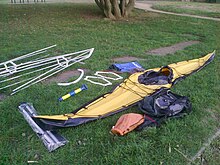
A special type of skin-on-frame kayak is the folding kayak. It has a collapsible frame, of wood, aluminum or plastic, or a combination thereof, and a skin of water-resistant and durable fabric. Many types have air sponsons built into the hull, making the kayak float even if flooded.
現代設計
[編輯]
Most modern kayaks differ greatly from native kayaks in design, manufacturing and usage. They are often designed with computer-aided design (CAD) software, often in combination with CAD customized for naval design.
Modern kayaks serve diverse purposes, ranging from slow and easy touring on placid water, to racing and complex maneuvering in fast-moving whitewater, to fishing and long-distance ocean excursions. Modern forms, materials and construction techniques make it possible to effectively serve these needs while continuing to leverage the insights of the original Arctic inventors.
Kayaks are long—5.8米(19英尺), short—1.8米(6英尺), wide—110 cm(42英寸), or as narrow as the paddler's hips—for example 35 cm(14英寸). They may attach one or two stabilizing hulls (outriggers), have twin hulls like catamarans, inflate or fold. They move via paddles, pedals that turn propellers or underwater flippers, under sail, or motor. They're made of wood/canvas, wood, carbon fiber, fiberglass, Kevlar, polyethylene, polyester, rubberized fabric, neoprene, nitrylon, polyvinyl chloride (PVC), polyurethane, and aluminum. They may sport rudders, fins, bulkheads, seats, eyelets, foot braces and cargo hatches. They accommodate 1-3 or more paddlers/riders.
種類
[編輯]Modern kayaks have evolved into specialized types that may be broadly categorized according to their application as sea or touring kayaks, whitewater (or river) kayaks, surf kayaks, racing kayaks, fishing kayaks, and recreational kayaks. The broader kayak categories today are 'sit-in' (SI), which is inspired mainly by traditional kayak forms, 'sit-on-top' (SOT), which evolved from paddle boards that were outfitted with footrests and a backrest, 'hybrid', which are essentially canoes featuring a narrower beam and a reduced free board enabling the paddler to propel them from the middle of the boat, using a double blade paddle (i.e. 'kayak paddle'), and twin hull kayaks offering each of the paddler's legs a narrow hull of its own. In recent decades, kayaks design have proliferated to a point where the only broadly accepted denominator for them is their being designed mainly for paddling using a kayak paddle featuring two blades i.e. 'kayak paddle'. However, even this inclusive definition is being challenged by other means of human powered propulsion, such as foot activated pedal drives combined with rotating or sideways moving propellers, electric motors, and even outboard motors.
休閒皮艇
[編輯]

Recreational kayaks are designed for the casual paddler interested in fishing, photography, or a peaceful paddle on a lake, flatwater stream or protected salt water away from strong ocean waves. These boats presently make up the largest segment of kayak sales. Compared to other kayaks, recreational kayaks have a larger cockpit for easier entry and exit and a wider beam (69—91 cm(27—36英寸)) for more stability. They are generally less than 3.7米(12英尺) in length and have limited cargo capacity. Less expensive materials like polyethylene and fewer options keep these boats relatively inexpensive. Most canoe/kayak clubs offer introductory instruction in recreational boats. They do not perform as well in the sea. The recreational kayak is usually a type of touring kayak.
航海皮艇
[編輯]
Sea kayaks are typically designed for travel by one, two or even three paddlers on open water and in many cases trade maneuverability for seaworthiness, stability, and cargo capacity. Sea-kayak sub-types include "skin-on-frame" kayaks with traditionally constructed frames, open-deck "sit-on-top" kayaks, and recreational kayaks.
The sea kayak, though descended directly from traditional types, is implemented in a variety of materials. Sea kayaks typically have a longer waterline, and provisions for below-deck storage of cargo. Sea kayaks may also have rudders or skegs (fixed rudder) and upturned bow or stern profiles for wave shedding. Modern sea kayaks usually have two or more internal bulkheads. Some models can accommodate two or sometimes three paddlers.
開放式皮艇
[編輯]

Sealed-hull ("unsinkable") craft were developed for leisure use, as derivatives of surfboards (e.g. paddle or wave skis), or for surf conditions. Variants include planing surf craft, touring kayaks, and sea marathon kayaks. Increasingly, manufacturers build leisure 'sit-on-top' variants of extreme sports craft, typically using polyethylene to ensure strength and affordability, often with a skeg for directional stability.
Sit-on-top kayaks come in 1-4 paddler configurations. Sit-on-top kayaks are particularly popular for fishing and SCUBA diving, since participants need to easily enter and exit the water, change seating positions, and access hatches and storage wells. Ordinarily the seat of a sit-on-top is slightly above water level, so the center of gravity for the paddler is higher than in a traditional kayak. To compensate for the higher center of gravity, sit-on-tops are often wider and slower than a traditional kayak of the same length.
Water that enters the cockpit of a sit-on-top kayak drains out through scupper holes—tubes that run from the cockpit to the bottom of the hull. The cockpit is thus self-bailing. The hull may be sealed, or perforated by hatches and deck fixtures. Contrary to popular belief, the sit-on-top kayak hull is not self-bailing, since water penetrating it does not drain out automatically, as it does in bigger boats equipped with self-bailing systems. Furthermore, the sit-on-top hull cannot be molded in a way that would assure water tightness, and water may get in through various holes in its hull, usually around hatches and deck accessories. If the sit-on-top kayak is loaded to a point where such perforations are covered with water, or if the water paddled is rough enough that such perforations often go under water, the sit-on-top hull may fill with water without the paddler noticing it in time. If a sealed hull develops a split or hole, it will also fill and sink.
衝浪皮艇
[編輯]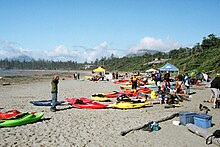
Specialty surf boats typically have flat bottoms, and hard edges, similar to surf boards. The design of a surf kayak promotes the use of an ocean surf wave (moving wave) as opposed to a river or feature wave (moving water). They are typically made from rotomolded plastic, or fiberglass.
Surf kayaking comes in two main varieties, High Performance (HP) and International Class (IC). High Performance boats tend to have a lot of nose rocker, little to no tail rocker, flat hulls, sharp rails and up to four fins set up as either a three fin thruster or a quad finTemplate:According to whom. This enables them to move at high speed and maneuver dynamically. International Class boats have to be at least 3米(9.8英尺) long and until a recent rule change[何時?] had to have a convex hull; now flat and slightly concave hulls are also allowed, although fins are not. Surfing on international boats tends to be smoother and more flowing, and they are thought of as kayaking's long boarding. Surf boats come in a variety of materials ranging from tough but heavy plastics to super light, super stiff but fragile foam–cored carbon fiber. Surf kayaking has become popular in traditional surfing locations, as well as new locations such as the Great Lakes.
衝浪板艇
[編輯]
A variation on the closed-cockpit surf kayak is called a waveski. Although the waveski offers dynamics similar to a sit–on–top, its paddling technique and surfing performance and construction can be similar to surfboard designs.
白水皮艇
[編輯]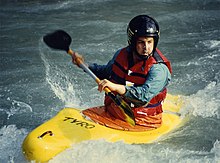
Whitewater kayaks are rotomolded in a semi-rigid, high impact plastic, usually polyethylene. Careful construction ensures that the boat remains structurally sound when subjected to fast-moving water. The plastic hull allows these kayaks to bounce off rocks without leaking, although they scratch and eventually puncture with enough use. Whitewater kayaks range from 1.2至3.0米(4至10英尺) long. There are two main types of whitewater kayak, playboats and river-running boats. Creekboats (for small rivers) and squirt boats are more specialized.
自由皮艇
[編輯]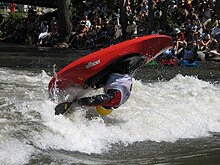
One type, the playboat, is short, with a scooped bow and blunt stern. These trade speed and stability for high maneuverability. Their primary use is performing tricks in individual water features or short stretches of river. In playboating or freestyle competition (also known as rodeo boating), kayakers exploit the complex currents of rapids to execute a series of tricks, which are scored for skill and style.
溪流皮艇
[編輯]The other primary type is the creek boat, which gets its name from its purpose: running narrow, low-volume waterways. Creekboats are longer and have far more volume than playboats, which makes them more stable, faster and higher-floating. Many paddlers use creekboats in "short boat" downriver races, and they are often seen on large rivers where their extra stability and speed may be necessary to get through rapids.
Between the creekboat and playboat extremes is a category called river–running kayaks. These medium–sized boats are designed for rivers of moderate to high volume, and some, known as river running playboats, are capable of basic playboating moves. They are typically owned by paddlers who do not have enough whitewater involvement to warrant the purchase of more–specialized boats.
潛水皮艇
[編輯]
Squirt boating involves paddling both on the surface of the river and underwater. Squirt boats must be custom-fitted to the paddler to ensure comfort while maintaining the low interior volume necessary to allow the paddler to submerge completely in the river.
競賽皮艇
[編輯]白水競技
[編輯]White water racers combine a fast, unstable lower hull portion with a flared upper hull portion to combine flat water racing speed with extra stability in open water: they are not fitted with rudders and have similar maneuverability to flat water racers. They usually require substantial skill to achieve stability, due to extremely narrow hulls. Whitewater racing kayaks, like all racing kayaks, are made to regulation lengths, usually of fiber reinforced resin (usually epoxy or polyester reinforced with Kevlar, glass fiber, carbon fiber, or some combination). This form of construction is stiffer and has a harder skin than non-reinforced plastic construction such as rotomolded polyethylene: stiffer means faster, and harder means fewer scratches and therefore also faster.
靜水競速
[編輯]
Sprint kayak is a sport held on calm water. Crews or individuals race over 200 m, 500 m, 1000 m or 5000 m with the winning boat being the first to cross the finish line. The paddler is seated, facing forward, and uses a double-bladed paddle pulling the blade through the water on alternate sides to propel the boat forward. In competition the number of paddlers within a boat is indicated by a figure besides the type of boat; K1 signifies an individual kayak race, K2 pairs, and K4 four-person crews. Kayak sprint has been in every summer olympics since it debuted at the 1936 summer olympics.[34] Racing is governed by the International Canoe Federation.
激流皮艇
[編輯]Slalom kayaks are flat–hulled, and—since the early 1970s—feature low profile decks. They are highly maneuverable, and stable but not fast in a straight line.
衝浪橇
[編輯]
A specialized variant of racing craft called a surf ski has an open cockpit and can be up to 6.4米(21英尺) long but only 46 cm(18英寸) wide, requiring expert balance and paddling skill. Surf skis were originally created for surf and are still used in races in New Zealand, Australia, and South Africa. They have become popular in the United States for ocean races, lake races and even downriver races.
馬拉松皮艇
[編輯]Marathon races vary in distances from ten kilometres to over 1000 kilometres for multi-day stage races.
特用皮艇和混合皮艇
[編輯]在現代,任何外形上與傳統皮艇相似的雙頭槳小艇都會被稱為「皮艇」。
充氣皮艇
[編輯]
充氣皮艇(inflatable kayak,也稱duckie)通常用氯丁橡膠、丁腈橡膠、聚氯乙烯或聚氨酯布料製成,充氣的時候可以使用腳踏、手壓或電動氣泵。這些皮艇通常會採用水密隔艙設計來提高安全性,並且通常會使用低於0.2 bar(3 psi)的氣壓充氣。
雖然許多在河流和平緩水域使用的充氣皮艇都是軟式的,高端的充氣皮艇通常都設計得較為剛硬,以便在海面使用。近期一些製造商給多隔艙的充氣艇加上了可摺疊的內部框架增強抗風浪性。
充氣皮艇的賣點主要在其洩氣後易於搬運、因有一定的柔性和彈性也更加耐用(不像硬體皮艇那樣容易磕碰出坑窪和裂紋)、在白水情況下更為堅固(因為碰到礁石可以彈走而不是直接撞毀)、並且可以袋裝儲存方便。此外充氣皮艇通常非常穩定,轉彎半徑小,而且易於掌握,雖然一些型號划槳起來更加吃力,速度也比傳統皮艇更慢。
摺疊皮艇
[編輯]
摺疊皮艇(folding kayak,也稱foldboat)是因紐特人和格林蘭傳統皮框艇的直系後裔。現代摺疊皮艇使用木製或鋁合金框架,外包由聚酯、棉制帆布、聚氨酯或氯丁橡膠等合成材料製成的外皮。它們比充氣皮艇要更加昂貴,但是剛度和航海性都更好。
瑞士人沃爾特·霍恩(Walter Höhn)在1924至1927年間就製造、研發並在白水河流上試驗他的摺疊皮艇設計。他在1928年移民到澳大利亞時帶去了兩艘,在將設計註冊了專利後就開始生產。到了1942年,澳大利亞軍方與霍恩接觸並要求他幫助研發軍用皮艇。一共1024艘基於霍恩1942年專利(117779號)的Ⅱ型和Ⅲ型皮艇被先後生產[35]。
腳蹬皮艇
[編輯]腳蹬皮艇(pedal kayak)可以使用自行車踏板式的機構來通過水下的螺旋槳或人造「腹鰭」驅動皮艇。與划槳的皮艇不同,腳蹬皮艇的艇手用腿部肌肉發力,耐力較為持久之外還可以解放雙手,因此腳蹬皮艇在垂釣愛好者中比較受歡迎[36]。
雙體船和支腿船
[編輯]傳統的多體船(multi-hull),比如雙體船(catamaran)和裝有支腿(outrigger)的划艇可以在不犧牲速度的情況下改善側向平穩度,而這些技術也被應用到了皮艇上。支腿皮艇(outrigger kayak)可以在艇身側面配裝一個或兩個支腿增加穩定性,特別是用於垂釣、旅行、風帆航行和使用摩托皮艇的時候。而雙體皮艇(twin hull kayak)則使用兩個離中線較遠分開的艇身,因此比單純配有支腿的單體皮艇要更加穩定。
垂釣皮艇
[編輯]
雖然北極地區的原住民通常是用皮艇打獵而不是捕魚,但近年來皮艇最常見是被用來在溫暖地區進行淡水和鹹水水域的休閒垂釣。傳統的垂釣皮艇通常艇寬較大可以達到1.1米(42英寸),有很好的側向(初級)穩定性,有些還裝有支腿來進一步增加穩定性,甚至有些採用雙體船身讓艇手可以站起來釣魚。與摩托艇相比,垂釣皮艇成本低且維修便宜,許多釣魚艇手還會對皮艇做出個性化的改裝。
軍用皮艇
[編輯]
皮艇在第二次世界大戰中被投入軍用,主要由英國突擊隊和特種空勤團等特種部隊使用,特別是聯合作戰領航隊(Combined Operations Pilotage Parties,簡稱COPP)、特殊舟艇隊和皇家海軍陸戰隊巡邏支隊(Boom Patrol Detachment),尤其是曾在弗蘭克頓行動(Operation Frankton)中突襲波爾多港[37]。特種空勤團和特殊舟艇隊在1982年馬島戰爭中也使用皮艇做偵察[38]。美國海豹突擊隊據說在1992年索馬利亞內戰初期的統一特遣隊(Unified Task Force)行動中也使用了皮艇[39]。
特殊舟艇隊現在使用可以基於潛艇(浮出水面時下水,或下潛時用潛水員送到水面)的克萊珀雙人摺疊皮艇。這些皮艇也可以用運輸機傘降或從「支努干」直升機的後艙投下[40]。美國特種作戰部隊也曾使用克萊珀皮艇,但現在主要使用美國自產的「長途」(Long Haul)牌摺疊皮艇[41]。
澳大利亞軍隊在1941~1945年間的太平洋戰爭中曾大量使用MKII和MKIII型摺疊皮艇對東南亞諸島實施了33次突襲任務,詳細記錄可在澳洲國家檔案館的NAA K1214-123/1/06號檔案中找到。這些皮艇通常從偽裝的艦艇、潛艇、卡特琳娜水上飛機、PT艇和摩托艇下水或傘降投入作戰[42]。
參考
[編輯]- ^ 存档副本 (PDF). [2021-09-05]. (原始內容存檔 (PDF)於2019-02-14).
- ^ History of Kayak: Eskimos 4000 Years Vision Realized – Kayak Information and Reviews. www.waterkayaking.com. [2021-03-05]. (原始內容存檔於2021-06-03) (英國英語).
- ^ (英語) Voelkerkundemuseum-muenchen.de 網際網路檔案館的存檔,存檔日期2008-03-12.
- ^ D.C. Hutchinson, "The Complete Book of Sea Kayaking", 5th ed., Falcon Guides, Connecticut.
- ^ Altenhofer, Der Hadernkahn, Pollner Verlag, 1997, pg 143, ISBN 3925660097
- ^ Dyson, Baidarka, Alaska Northwest Publishing Company, 1986, p 80-81, ISBN 978-0882403151
- ^ 7.0 7.1 Cuthbert, Penny. Oskar Speck : 50,000 kilometres by kayak. Australian National Maritime Museum. 2011. ISBN 9780977547128.
- ^ 8.0 8.1 Escobar, S. Being a hero is all about timing: Oskar Speck's kayak voyage. Australian National Maritime Museum. 2015 [19 April 2021]. (原始內容存檔於2021-05-18).
- ^ Prochnau, W. From Nazi Germany to Australia: The Incredible True Story of History's Longest Kayak Journey. Vanity Fair. 2018 [22 March 2021]. (原始內容存檔於2021-04-23).
- ^ NSW Sea Kayaker. Incredible Journey [50]. online - reprint from Australasian Post Magazine. 2002 [22 March 2021]. (原始內容存檔於2020-11-11).
- ^ Worsley, P. A quarterly publication of the Maritime Heritage Association, Inc (PDF). Maritime Heritage Association Journal. 2007, 18 (3): 13–19 [2021-09-13]. (原始內容存檔 (PDF)於2021-03-14).
- ^ 「Renew Attempt To Row Boat Across Atlantic,」 Messenger Inquirer, April 23, 1928; 「In A Rubber Boat Over The Sea,」 Baltimore Sun, September 30, 1928; 「Rowing Around World In A Canvas Boat,」 Bradford Evening Star, November 13, 1935
- ^ 「Only Three Shoot Rapids,」 Philadelphia Inquirer, July 7, 1940
- ^ Cockleshell on the Colorado, American Whitewater Vol 4, No 2, p 6-13, P2P p 426
- ^ 「How It Feels To Run Treacherous Rapids Of Colorado River Related By Altadenan,」 Pasadena Post, July 28, 1941><ref Marston, From Powell to Power, Vishnutemple Press, 2014, p 424, {{ISBN|9780990527022}}
- ^ Martin, Big Water Little Boats, Vishnu Temple Press, 2012, pg. 190, ISBN 9780979505560
- ^ Kayarchy - contents of chapter on sea kayaking safety. kayarchy.com. [2021-09-05]. (原始內容存檔於2021-04-11).
- ^ Kayarchy - paddling your sea kayak (1) starting out. kayarchy.com. [2021-09-05]. (原始內容存檔於2021-04-11).
- ^ 19.0 19.1 19.2 19.3 19.4 19.5 Kayarchy - the kayak. kayarchy.com. [2021-09-05]. (原始內容存檔於2021-09-05).
- ^ 20.0 20.1 20.2 20.3 Kayarchy - sea kayak design. kayarchy.com. [2021-09-05]. (原始內容存檔於2021-09-05).
- ^ 21.0 21.1 21.2 21.3 Kayarchy - retail outlets (3) sea kayaks & paddles. kayarchy.com. [2021-09-05]. (原始內容存檔於2021-09-05).
- ^ 22.0 22.1 22.2 22.3 22.4 Kayarchy - sea kayaking for kids. kayarchy.com. [2021-09-05]. (原始內容存檔於2021-09-05).
- ^ 存档副本 (PDF). [2021-09-05]. (原始內容存檔 (PDF)於2021-11-03).
- ^ 存档副本 (PDF). [2021-09-05]. (原始內容存檔 (PDF)於2011-02-05).
- ^ Car-Topping and Strapping Down a Kayak. Kayak Roof Racks. 2016-05-14 [2018-05-23]. (原始內容存檔於2021-09-05) (美國英語).
- ^ How to Store a Kayak. wikiHow. [2018-05-23]. (原始內容存檔於2021-09-05) (英語).
- ^ kayakways.net - Kayak Fitting. www.kayakways.net. [2021-09-05]. (原始內容存檔於2020-02-24).
- ^ Championships. www.traditionalkayaks.com. [2021-09-05]. (原始內容存檔於2021-04-22).
- ^ Greenland National Championships in Sisimiut 2006. [2021-09-05]. (原始內容存檔於2021-09-05).
- ^ Hobie Gear SideKick AMA Kit Hobie Kayak Outrigger. [2021-09-05]. (原始內容存檔於2019-04-11).
- ^ Outriggers – Wavewalk® Stable Fishing Kayaks, Portable Boats and Skiffs. [2021-09-05]. (原始內容存檔於2020-08-12).
- ^ Crowhurst, Christopher. Masik designs for modern kayaks. Qajaq Rolls. 25 September 2012 [2021-09-05]. (原始內容存檔於2021-09-05).
- ^ Jason Weisberger. Xyla Foxlin makes a clear kayak with LED lights. Boing Boing magazine. January 16, 2021 [July 8, 2021]. (原始內容存檔於2021-11-04).
...(she calls it the 'Rainbowt')...
- ^ ICF - Canoe Sprint. International Canoe Federation. [18 July 2014]. (原始內容存檔於8 October 2010).
- ^ Commando Kayak 2011, ISBN 978-3-033-01717-7
- ^ Pedal Kayaks. Mariner-Sails. Mariner Sails Inc. [3 November 2020]. (原始內容存檔於2021-11-06).
- ^ Tweedie, Neil. Cockleshell Heroes: the truth at last. 2010-10-28 [2018-05-23]. ISSN 0307-1235. (原始內容存檔於August 28, 2012) (英國英語).
|journal=被忽略 (幫助) - ^ James D. Ladd, SBS, The Invisible Raiders: the History of the Special Boat Squadron from World War Two to the Present, Arms & Armour Press 1983, ISBN 978-0-85368-593-7 (p.231)
- ^ Canada's special forces to get ancient war-fighting machines: canoes - The Star. thestar.com. [2021-09-05]. (原始內容存檔於2021-09-05).
- ^ specialboatservice.co.uk. www.specialboatservice.co.uk. [2021-09-05]. (原始內容存檔於2012-09-15).
- ^ Kayaks | Canoes | Special Operations Forces. www.americanspecialops.com. [2018-05-23]. (原始內容存檔於2021-12-20).
- ^ Commando Kayak, Hoehn, 2011.
